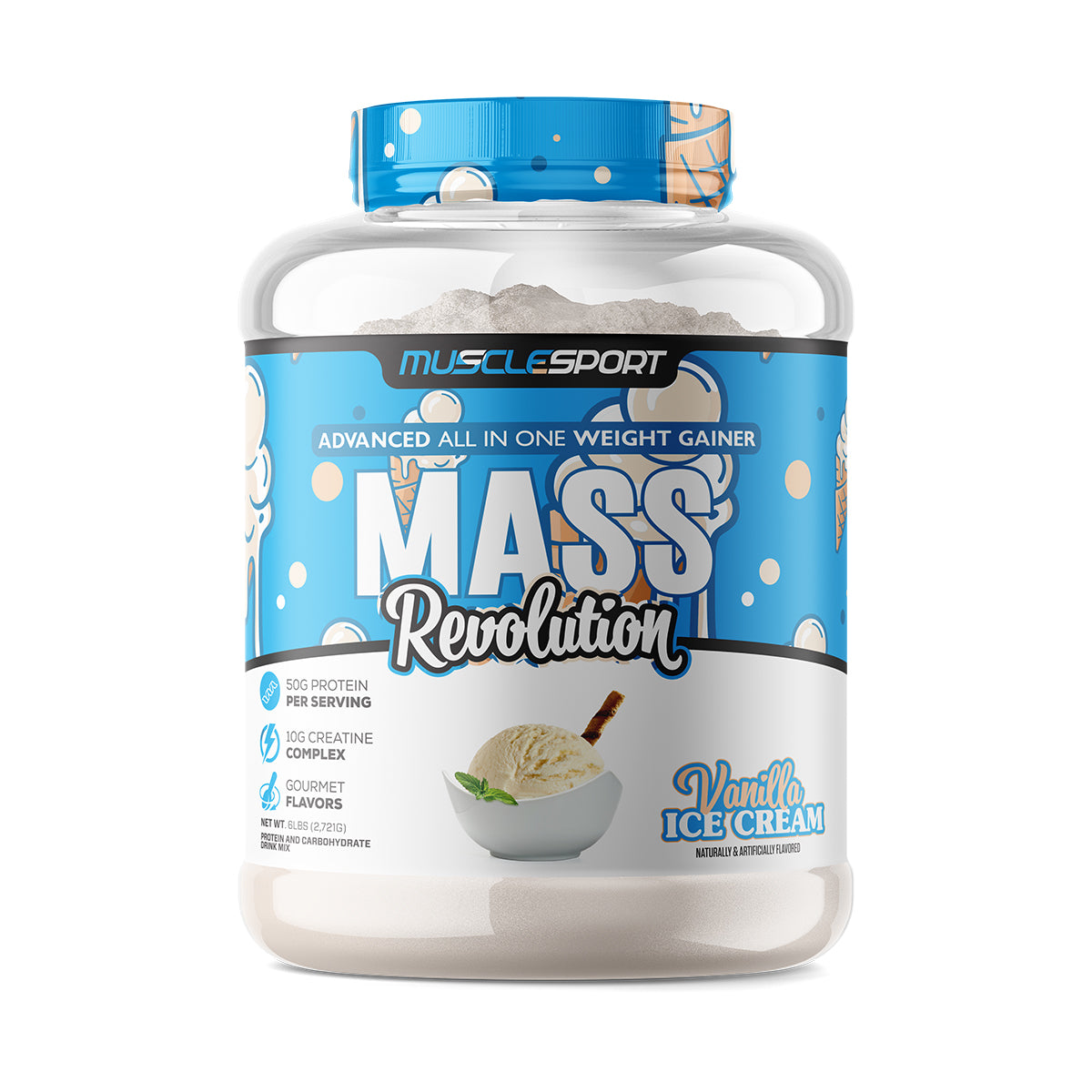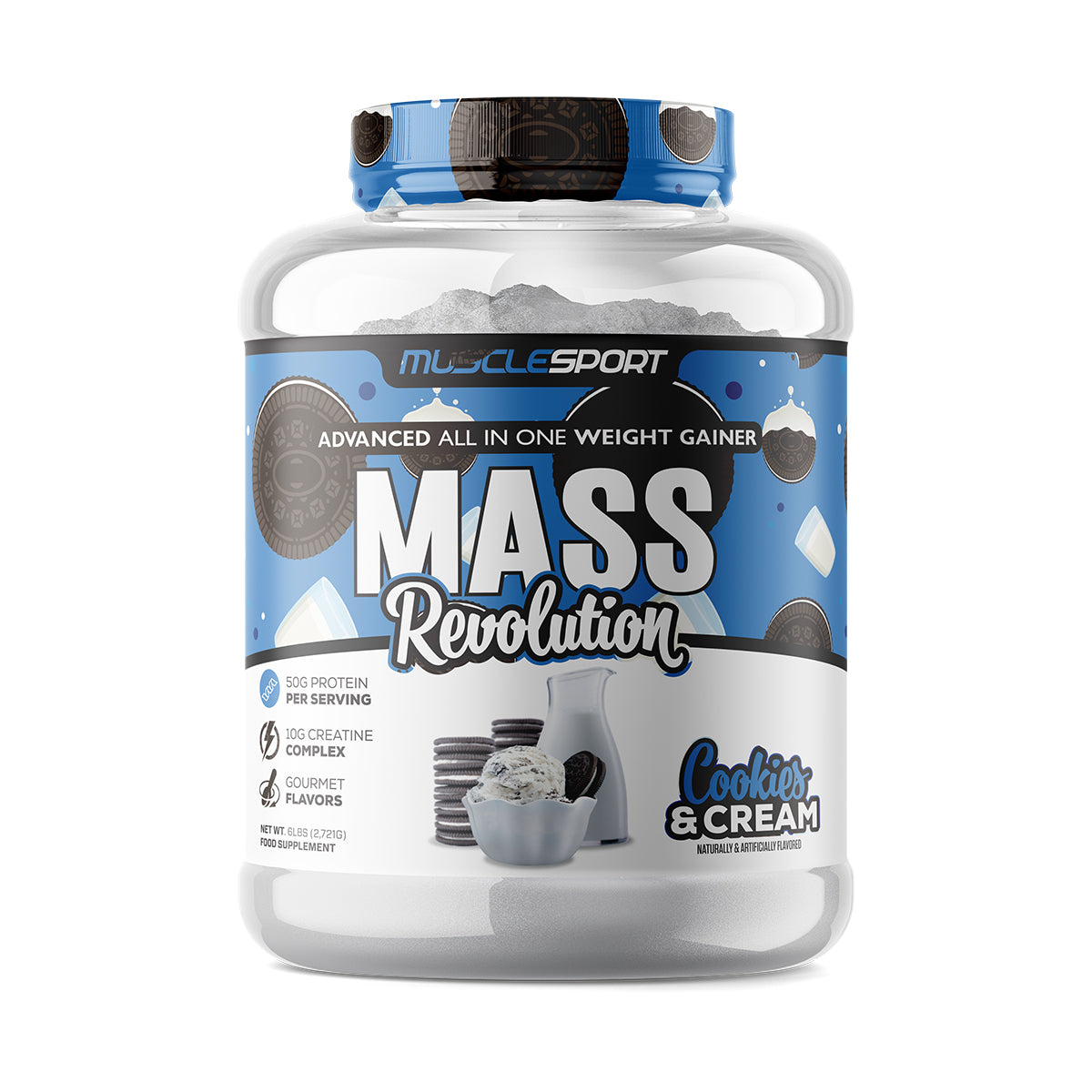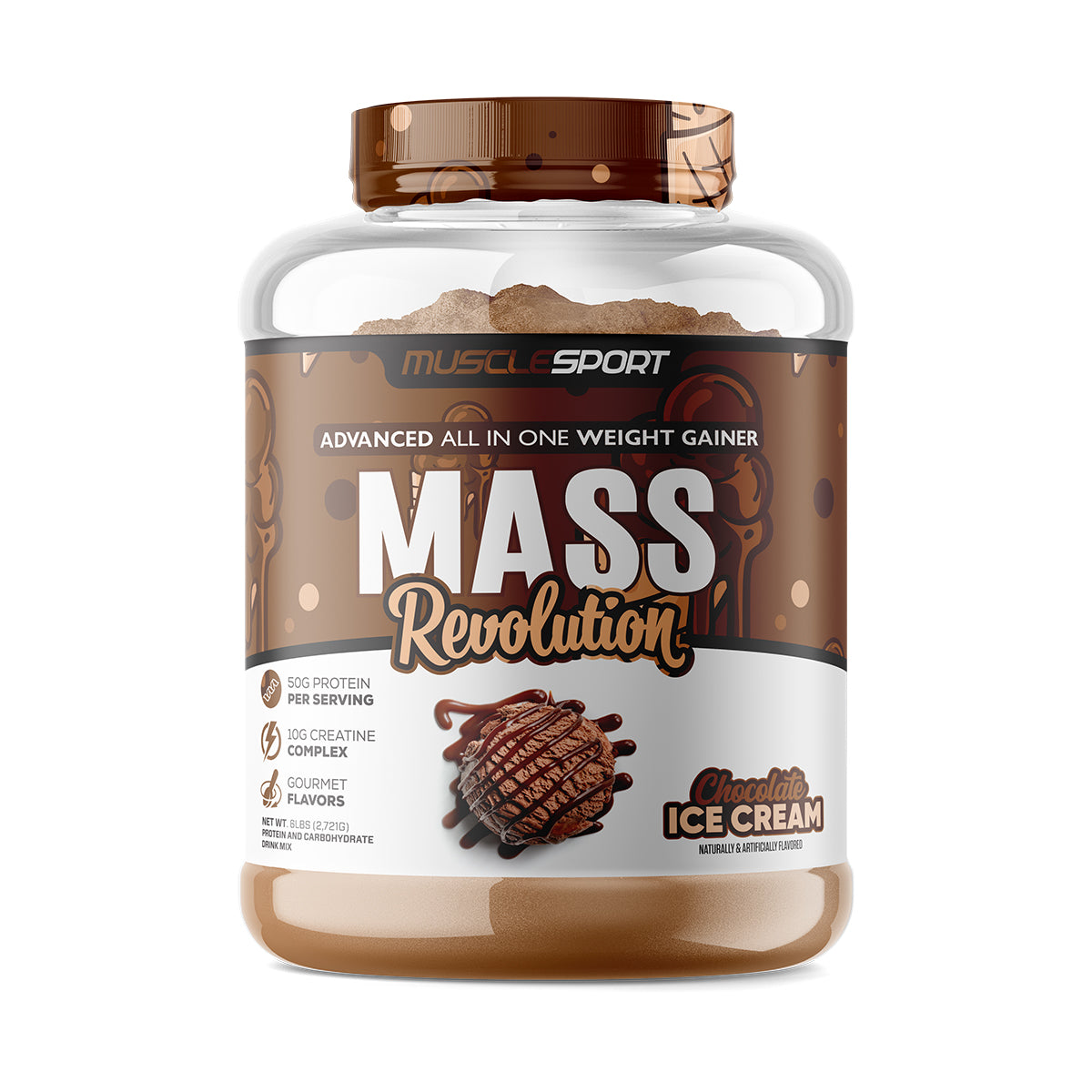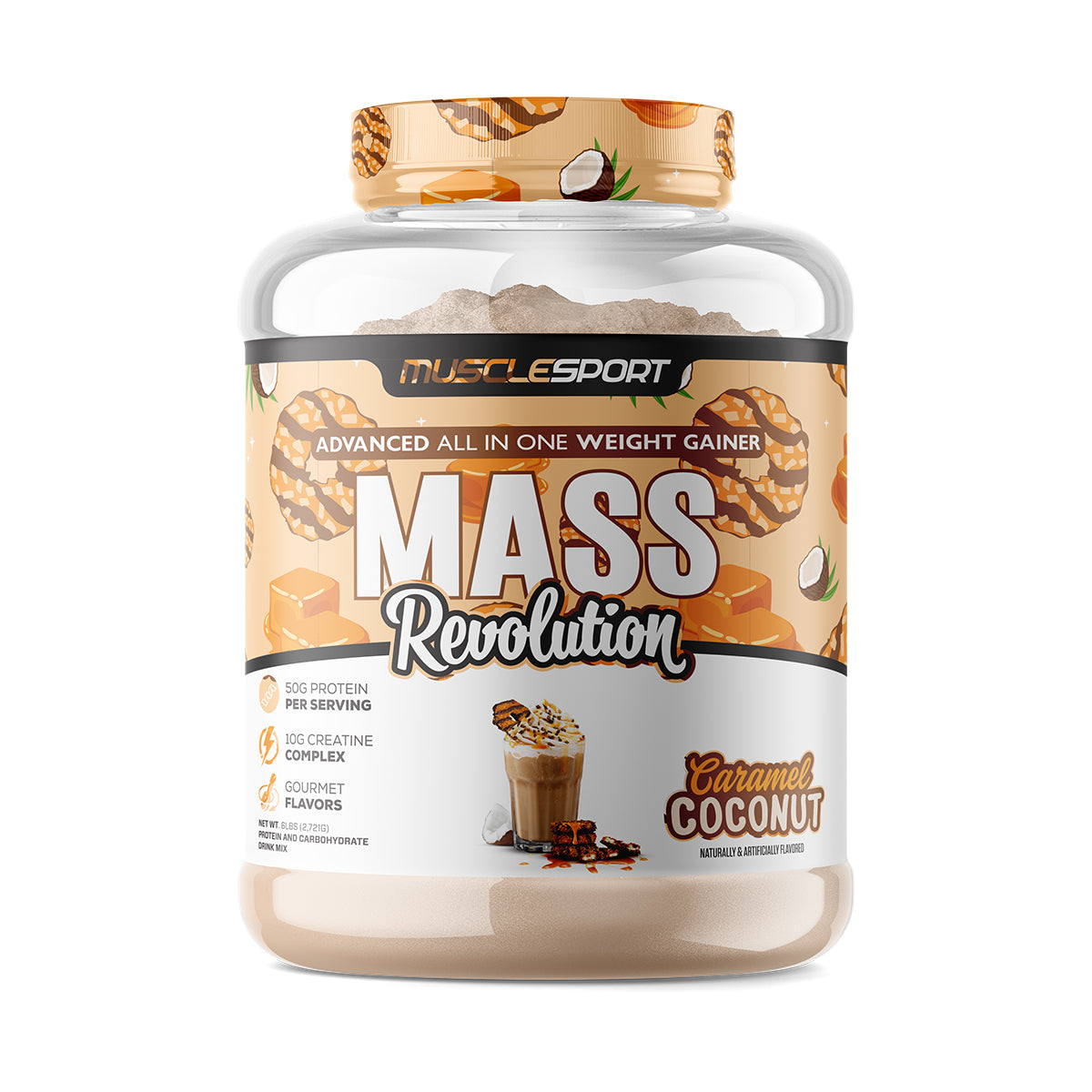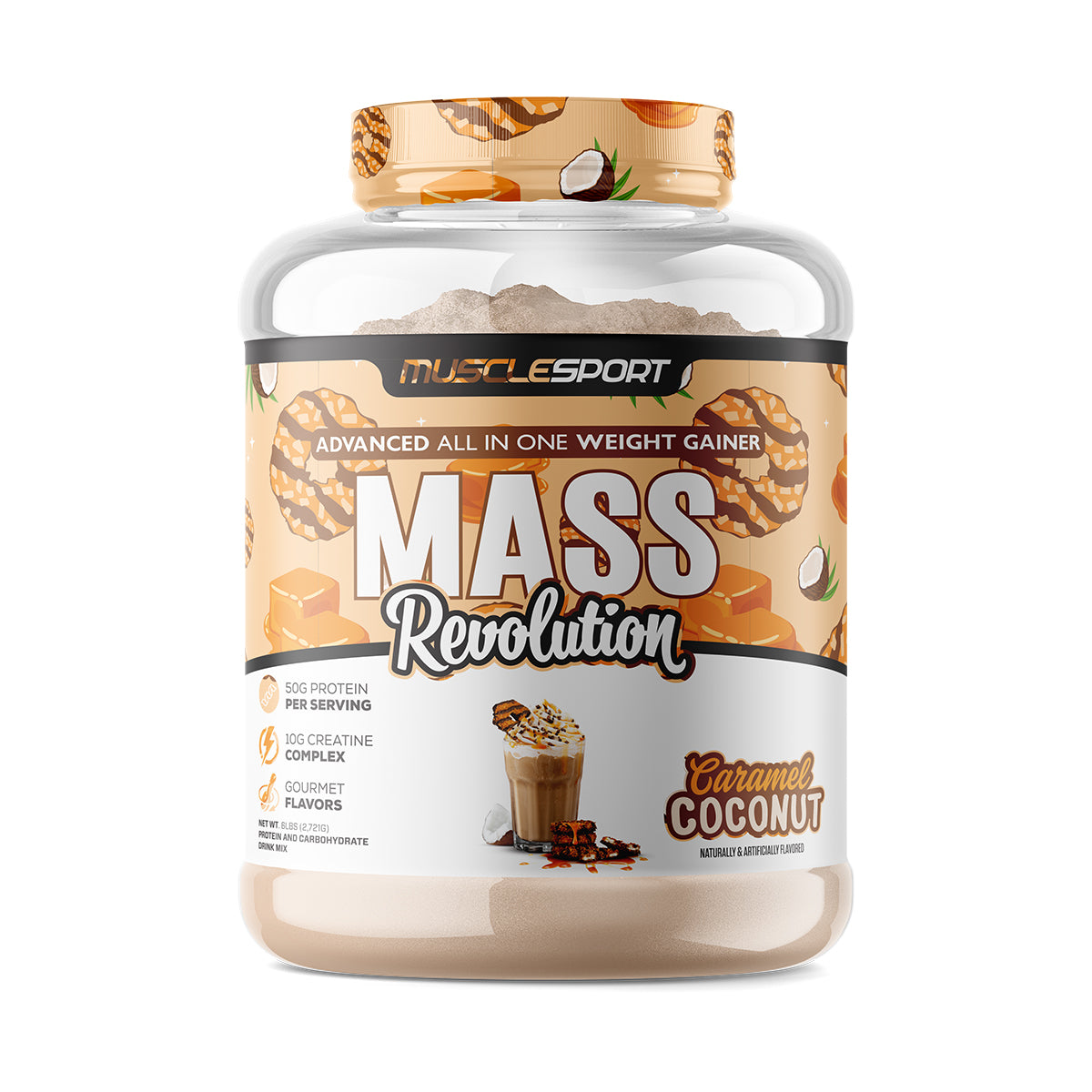Mass Revolution™ Mass Gainer 6lb
Advanced All-in-One Weight Gainer*
- 150g of clean carbs, 25g of ultra high-quality proteins and only 6g of fats per serving
- 5-hour time-release muscle feeder & a 6:1 Carb to Protein ratio*
- Contains 4 different types of complete, high-leucine proteins that quickly increase blood amino acid levels*
- Key enzymes for the proper digestion and subsequent absorption of dairy proteins to maximize uptake without any upset stomach*
- Delicious flavors
Description
Whether you are a hard gainer or you’ve just found yourself needing an edge to break through a plateau, MASS REVOLUTION™ is the gainer that can make it happen.
Often times, bulking forces situations requiring a few dirty calories in order to force the body into building muscle.
However, this frequently leads to putting on substantially more fat than is necessary. After all, you can’t always get all the calories you need from eating clean.
Even if you can, all those solids pack the digestive system, and some liquid calories go a LONG way in relieving distress – anyone who’s ever been on a quest for epic mass knows what this feels like.
MASS REVOLUTION™ is our Lean Muscle building formula. With a 5-hour time-release muscle feeder & a 6:1 Carb to Protein ratio, MASS REVOLUTION™ will help you put on quality lean mass quickly.
Let’s take a look inside the jug:
- Rapid Mass Carb Matrix – A specialized blend of 6 carbohydrate sources designed to get into the muscle quick to maintain anabolism with slow-digesting carbs to feed muscles for hours without overflow to fat conversion.
- Rapid Mass Muscle Stimulation Protein Matrix – Don’t miss 1 second of anabolism. Contains 4 different types of complete, high-leucine proteins that quickly increase blood amino acid levels while simultaneously sustaining the elevation all the way to your next meal.
- Mass Stack Blend – A Powerful combination of the world’s single most effective muscle-building supplement, Creatine, and the vasodilator, Agmatine Sulfate.
- Lactase and Protease – 2 key enzymes for the proper digestion and subsequent absorption of dairy proteins to maximize uptake without any upset stomach.
MASS REVOLUTION™ allows you to get 150g of clean carbs, 25g of ultra high-quality proteins and only 6g of fats per serving. Of course, you can always adjust this as you get even bigger!
These sort of calories added post-workout can really add a huge boost to your gains!
*These statements have not been evaluated by the Food and Drug Administration. This product is not intended to diagnose, treat, cure, or prevent any disease.
Supplement Facts

Ingredient Profile
RAPID MASS MUSCLE STIMULATION PROTEIN MATRIX
Whey Protein
Proteins provide the building blocks of muscle via their constituent amino acids. However, quality, digestion rate, and source should be considered when selecting a protein.
In general, the essential amino acid content determines the quality of the protein. In particular, two to three grams of leucine is needed to optimize protein synthesis. Whey contains 11% leucine, making it one of the highest quality proteins available.
Whey is also very water soluble, mixes easily, and digests rapidly which is important for stimulating muscle protein synthesis after a hard training session. After ingestion of whey, amino acids levels in the blood are elevated after 30 minutes, remain elevated for several hours, and return to baseline after ~5 hours.
This is why it is recommended to consume protein (25-30 grams optimally) every 3-4 hours when trying to build muscle; to keep amino acids levels in the blood elevated which will continue muscle protein synthesis and help promote recovery and repair of damaged muscle tissue.
Whey (milk based) proteins may also have positive effects on glycogen replenishment following exercise. Research has demonstrated that the addition of protein to a moderate carbohydrate beverage may speed glycogen replenishment following a hard training session.
Since glycogen supplies a significant amount of energy needs during intense training, it is important to have stores replenished in order to meet the needs of subsequent training sessions.
Lastly, milk based proteins have many significant health benefits that many tend to overlook. For example, lactalbumin, a peptide found in whey appears to play a role in enhancing lymphatic and immune support, may enhance cognitive function, improve sleep, and has many antioxidant properties. Whey protein in general:
- Promotes muscle protein synthesis
- Digests and absorbs quickly
- Increases lean mass
- Increase power and strength via the increase in muscle size
- Speeds recovery from muscle damaging exercises
- Increases glycogen replenishment
- Contains highest amount of leucine compared to other sources
- May decrease body weight gain
Whey Protein Concentrate:
Whey protein concentrate is the most common form of whey, a byproduct formed when acid is added to milk.
- Whey protein concentrate is the closest to whole food compared to other forms of protein and is 75-85% pure protein after filtration.
- A growing body of evidence suggests that dairy protein, and whey in particular may: 1) stimulate the greatest rise in muscle protein synthesis, 2) result in greater muscle cross-sectional area when combined with chronic resistance training, and 3) at least in younger individuals, enhance exercise recovery.
Whey Protein Isolate
Whey protein isolates digest and absorb rapidly and are, gram for gram, the most refined and purest form of protein (90-98% pure protein).
- It is also a potent stimulator of muscle protein synthesis due to its ability to causes a rapid increase in amino acids found in the blood stream.
- This form of whey contains little to no lactose so it may be beneficial for individuals who experience GI problems. Also due to the refinement process whey isolate contains little fat, carbs, and milk sugars.
- A 2006 study conducted by Cribb et al. found recreational bodybuilders who supplemented with whey protein isolate in conjunction with a 10-week resistance training program achieved greater gains in lean mass, strength, and decreases in body fat compared to a placebo group.
Whey Protein Peptides
Whey protein peptides are pre-digested proteins (broken down into amino acids).
- This breakdown leads to faster absorption by the body thus rapidly rebuilding and repairing muscles after a workout.
MUSCLE PRESERVATION MATRIX
L-Taurine
Taurine has a myriad of benefits. From helping the body to metabolize fat, improving carbohydrate metabolism, raising testosterone levels, as an antioxidant, higher performance and quicker recovery during athletic training and increasing cardiovascular health… it goes without saying that taurine is a great ingredient to have in your wheelhouse
- Zhang et al. (2004) found that individuals who supplemented with taurine for 1 week before an exhaustive exercise bout significantly improved time to exhaustion, VO2 max, and maximal workload. It also decreased exercise-induced DNA damage
L-Glutamine
L-glutamine is the most prevalent free amino acid in plasma and one of the most prevalent found in muscle tissue.
- L-Glutamine stimulates muscle protein synthesis and is effective at replenishing energy for muscles (glycogen) after exhaustive exercise which may lead to quicker recovery.
- L-Glutamine may also increase cell volume (hydration) and lead to increases in muscle hypertrophy.
- L-Glutamine may also reduce protein breakdown and support immune function.
- Lehmkuhl et al. (2003) found individual supplementing with glutamine and creatine monohydrate for 8 weeks increased body mass, lean body mass and the initial rate of power production compared to placebo.
L-Leucine
Leucine is one of the essential branched chain amino acids (BCAA). By itself it can stimulate muscle protein synthesis; the process responsible for muscle growth and recovery.
This is why it is often referred to as the “main” amino acid.
- Supplementation with at least 2/grams daily leucine has been shown decrease muscle soreness, lessen recovery time between workouts, and increase lean muscle mass.
- Howatson et al. (2012) discovered that leucine (combined with isoleucine and valine) administered before muscle-damaging resistance exercises reduced indices of muscle damage and accelerated recovery in resistance trained males
L-Valine
Valine, one of the BCAAs, promotes muscular endurance and decreases fatigue during exercise.
- When exercising tryptophan is converted to serotonin and signals the brain that the body is fatigued…ultimately leading to a decrease in muscle strength and endurance
- Since Valine competes with tryptophan for entry into the brain and prevails, less serotonin gets to the brain; ultimately leading to stronger muscular contractions, quicker recovery between sets, and prolonged muscular strength and endurance.
DL-a-hydroxy-isocaproic acid (HICA)
HICA is short for DL-Alpha-Hydroxy-Isocaproic Acidand is the end result of leucine metabolism in human tissues.
- Studies have shown that HICA can enhance anaerobic and aerobic performance as well as help to promote optimal gains in muscle mass and muscle fiber size.
- However, the biggest benefit of HICA can be the reduction of delayed onset muscle soreness (DOMS).
- Mero et. al (2010) discovered male soccer players who supplemented with HICA over a 4 week period were able to increase whole lean body mass and reduce soreness by 23% compared to placebo.
NITROGEN RETENTION BLEND
Lactase/Protease
Protease and lactase help aid in protein digestion and absorption.
- These ingredients (enzymes) may help those individuals who experience nausea, cramping or bloating when consuming whey proteins.
Brewer's Yeast
Brewer's yeast provides a full spectrum of B vitamins including thiamine, riboflavin, niacin, pantothenic acid, and pyridoxine HCL.
- These B vitamins play a big role in converting food into fuel.
MASS STACK BLEND
Creatine MagnaPower
By combining magnesium to the creatine mixture in this compound – it allows (in a similar fashion to COP) the creatine to be absorbed and utilized for anabolic processes and prevents conversion to creatinine through the process of cyclization.
- Creatine MagnaPower pulls together both creatine and magnesium for the most effective ATP synthesis.
- The ISSN (International Society of Sports Nutrition) position stand on creatine monohydrate (CM) found that short-term CM supplementation has been reported to improve maximal power/strength (5–15%), work performed during sets of maximal effort muscle contractions (5–15%), single-effort sprint performance (1–5%), and work performed during repetitive sprint performance (5–15%). Long-term CM supplementation appears to enhance the overall quality of training, leading to 5 to 15% greater gains in strength and performance.
Agmatine Sulfate
Agmatine Sulfate helps improve nutrient partitioning which leads to an increase in muscle glycogen (carbs stored in muscle tissues) which then leads to more water retained WITHIN the muscle.
This creates a fuller look to the muscles and a greater pump while hitting the iron.
- Agmatine Sulfate also increases NO production by working as a competitive inhibitor of the enzyme NO Synthase.
- There are studies to suggest that the nutrient partitioning effects of agmatine sulfate are possibly due to its ability to increase the insulin response to carbohydrates. This could be further explained by the increased blood flow to the muscle that occurs with increased NO production.
- LH and GH levels have been shown to be increased through the effects of Agmatine Sulfate and its possible effects on the hypothalamus.
- Agmatine has also been shown to manipulate pain receptors which may allow you to train past normal pain thresholds.
NUTRIENT DELIVERY SYSTEM
Alpha Lipoic Acid
Alpha-Lipoic Acid (ALA) is a mitochondrial fatty acid that is highly involved in energy metabolism. It is synthesized in the body and can be consumed through eating meats and minimally in some fruits/vegetables.
- In supplement form, ALA has been shown to be a benefit against various forms of oxidation.
- ALA is a potent anti-oxidant compound. It works with mitochondria and the body’s natural anti-oxidant defenses.
FAQs
Q: What is the best way to take Mass Revolution?
A: As a dietary supplement beginner, take one serving (4 scoops) in 12 to 20 ounces of cold water or milk.
Advanced users should take one serving (8 scoops) with 24 to 36 ounces of cold water or milk.
For a total meal replacement, blend with ice and greens.
Q: How many calories does it take to put on an extra pound of muscle?
A: According to research it takes ~3500 calories to put on an additional one pound of muscle.
This amount should be broken down into an extra 500-1000 calories/day on top of your regular diet if you have hit a plateau in your weight gain goals.
Q: What other MuscleSport products do you recommend stacking with Mass Revolution?
A: If increased size and weight gain is the goal, we recommend stacking Mass Revolution with Test Revolution and one of our pre workouts for training sessions that make the most of extra calories.
References
Whey Protein as a whole
1. Campbell, B., Kreider, R. B., Ziegenfuss, T., La Bounty, P., Roberts, M., Burke, D., ... & Antonio, J. (2007). Journal of the International Society of Sports Nutrition. Journal of the International Society of Sports Nutrition, 4(8), 8.
2. Antonio, J., & Stout, J. R. (2001). Sports supplements. Lippincott Williams & Wilkins.
3. Smith-Ryan, A., & Antonio, J. (Eds.). (2013). Sports Nutrition & Performance Enhancing Supplements. Linus Learning.
4. Lemon, P. W. (1991). Protein and amino acid needs of the strength athlete. Int J Sport Nutr, 1(2), 127-145.
5. Zawadzki, K. M., Yaspelkis, B. B. D., & Ivy, J. L. (1992). Carbohydrate-protein complex increases the rate of muscle glycogen storage after exercise. Journal of Applied Physiology, 72(5), 1854-1859.
6. Markus, C. R., Olivier, B., & de Haan, E. H. (2002). Whey protein rich in α-lactalbumin increases the ratio of plasma tryptophan to the sum of the other large neutral amino acids and improves cognitive performance in stress-vulnerable subjects. The American journal of clinical nutrition, 75(6), 1051-1056.
7. Cockburn, E., Stevenson, E., Hayes, P. R., Robson-Ansley, P., & Howatson, G. (2010). Effect of milk-based carbohydrate-protein supplement timing on the attenuation of exercise-induced muscle damage. Applied Physiology, Nutrition, and Metabolism, 35(3), 270-277.
8. Wojcik, J. R., Walber-Rankin, J., Smith, L. L., & Gwazdauskas, F. C. (2001). Comparison of carbohydrate and milk-based beverages on muscle damage and glycogen following exercise. International journal of sport nutrition and exercise metabolism, 11(4), 406-419.
9. Belobrajdic, D. P., McIntosh, G. H., & Owens, J. A. (2004). A high-whey-protein diet reduces body weight gain and alters insulin sensitivity relative to red meat in wistar rats. The Journal of nutrition, 134(6), 1454-1458.
Whey Protein Concentrate
1. Hulmi, J. J., Lockwood, C. M., & Stout, J. R. (2010). Effect of protein/essential amino acids and resistance training on skeletal muscle hypertrophy: A case for whey protein. Nutrition & metabolism, 7(1), 1.
2. Hoffman, J. R., & Falvo, M. J. (2004). Protein-Which is best. Journal of Sports Science and Medicine, 3(3), 118-130.
3. Hayes, A., & Cribb, P. J. (2008). Effect of whey protein isolate on strength, body composition and muscle hypertrophy during resistance training. Current Opinion in Clinical Nutrition & Metabolic Care, 11(1), 40-44.
4. Volek, J. S., Volk, B. M., Gómez, A. L., Kunces, L. J., Kupchak, B. R., Freidenreich, D. J., ... & Quann, E. E. (2013). Whey protein supplementation during resistance training augments lean body mass. Journal of the American College of Nutrition, 32(2), 122-135.
5. Renan, M., Mekmene, O., Famelart, M. H., Guyomarc'h, F., Arnoult-Delest, V., Pâquet, D., & Brulé, G. (2006). the pH-Dependent behaviour of soluble protein aggregates formed during heat-treatment of milk at pH 6· 5 or 7· 2. Journal of dairy research, 73(01), 79-86.
Whey Protein Isolate
1. Hayes, A., & Cribb, P. J. (2008). Effect of whey protein isolate on strength, body composition and muscle hypertrophy during resistance training. Current Opinion in Clinical Nutrition & Metabolic Care, 11(1), 40-44.
2. Pal, S., Ellis, V., & Dhaliwal, S. (2010). Effects of whey protein isolate on body composition, lipids, insulin and glucose in overweight and obese individuals. British journal of nutrition, 104(05), 716-723.
3. Burd, N. A., Yang, Y., Moore, D. R., Tang, J. E., Tarnopolsky, M. A., & Phillips, S. M. (2012). Greater stimulation of myofibrillar protein synthesis with ingestion of whey protein isolate v. micellar casein at rest and after resistance exercise in elderly men. British Journal of nutrition, 108(06), 958-962.
4. Cooke, M. B., Rybalka, E., Stathis, C. G., Cribb, P. J., & Hayes, A. (2010). Whey protein isolate attenuates strength decline after eccentrically-induced muscle damage in healthy individuals. J Int Soc Sports Nutr, 7(1), 30.
5. Renan, M., Mekmene, O., Famelart, M. H., Guyomarc'h, F., Arnoult-Delest, V., Pâquet, D., & Brulé, G. (2006). the pH-Dependent behaviour of soluble protein aggregates formed during heat-treatment of milk at pH 6· 5 or 7· 2. Journal of dairy research, 73(01), 79-86.
6. Whetstine, M. C., Croissant, A. E., & Drake, M. A. (2005). Characterization of dried whey protein concentrate and isolate flavor. Journal of dairy science,88(11), 3826-3839.
Whey Protein Peptides
1. Farup, J., Rahbek, S. K., Vendelbo, M. H., Matzon, A., Hindhede, J., Bejder, A., ... & Vissing, K. (2014). Whey protein hydrolysate augments tendon and muscle hypertrophy independent of resistance exercise contraction mode. Scandinavian journal of medicine & science in sports, 24(5), 788-798.
2. Calbet, J. A., & MacLean, D. A. (2002). Plasma glucagon and insulin responses depend on the rate of appearance of amino acids after ingestion of different protein solutions in humans. The Journal of nutrition, 132(8), 2174-2182.
3. Calbet, J. A., & Holst, J. J. (2004). Gastric emptying, gastric secretion and enterogastrone response after administration of milk proteins or their peptide hydrolysates in humans. European journal of nutrition, 43(3), 127-139.
4. Buckley, J. D., Thomson, R. L., Coates, A. M., Howe, P. R., DeNichilo, M. O., & Rowney, M. K. (2010). Supplementation with a whey protein hydrolysate enhances recovery of muscle force-generating capacity following eccentric exercise. Journal of Science and Medicine in Sport, 13(1), 178-181.
Taurine
1. Zhang, M., Izumi, I., Kagamimori, S., Sokejima, S., Yamagami, T., Liu, Z., & Qi, B. (2004). Role of taurine supplementation to prevent exercise-induced oxidative stress in healthy young men. Amino acids, 26(2), 203-207.
2. BOUCHAMA, A., YUSUF, A., AL-SEDAIRY, S. U. L. T. A. N., & EL-YAZIGI, A. D. N. A. N. (1993). Alteration of taurine homeostasis in acute heatstroke.Critical care medicine, 21(4), 551-554.
3. Gwacham, N., & Wagner, D. R. (2012). Acute effects of a caffeine-taurine energy drink on repeated sprint performance of American college football players. Int J Sport Nutr Exerc Metab, 22(2), 109-116.
4. Warskulat, U., Brookmann, S., Felsner, I., Brenden, H., Grether‐Beck, S., & Häussinger, D. (2008). Ultraviolet A induces transport of compatible organic osmolytes in human dermal fibroblasts. Experimental dermatology, 17(12), 1031-1036.
L-Glutamine
1. Welbourne, T. C. (1995). "Increased plasma bicarbonate and growth hormone after an oral glutamine load". The American journal of clinical nutrition 61 (5): 1058–1061.
2. Morlion, B. J.; Stehle, P.; Wachtler, P.; Siedhoff, H. P.; Köller, M.; König, W.; Fürst, P.; Puchstein, C. (1998). "Total Parenteral Nutrition with Glutamine Dipeptide After Major Abdominal Surgery". Annals of Surgery 227 (2): 302–308.
3. Lee, W. J.; Hawkins, R. A.; Viña, J. R.; Peterson, D. R. (1998). "Glutamine transport by the blood-brain barrier: A possible mechanism for nitrogen removal". The American journal of physiology 274
4. Todorova, V. K., Kaufmann, Y., Luo, S., & Klimberg, V. S. (2011). Tamoxifen and raloxifene suppress the proliferation of estrogen receptor-negative cells through inhibition of glutamine uptake. [Research Support, U.S. Gov't, Non-P.H.S.]. Cancer Chemother Pharmacol, 67(2), 285-291.
5. Bowtell, J. L., Gelly, K., Jackman, M. L., Patel, A., Simeoni, M., & Rennie, M. J. (1999). Effect of oral glutamine on whole body carbohydrate storage during recovery from exhaustive exercise. Journal of Applied Physiology,86(6), 1770-1777.
L-Leucine/L-Valine
1. Norton, L. E., & Layman, D. K. (2006). Leucine regulates translation initiation of protein synthesis in skeletal muscle after exercise. The Journal of nutrition, 136(2), 533S-537S.
2. Shimomura, Y., Inaguma, A., Watanabe, S., Yamamoto, Y., Muramatsu, Y., Bajotto, G., ... & Mawatari, K. (2010). Branched-chain amino acid supplementation before squat exercise and delayed-onset muscle soreness.International journal of sport nutrition, 20(3), 236.
3. Nicastro, H., Artioli, G. G., dos Santos Costa, A., Solis, M. Y., Da Luz, C. R., Blachier, F., & Lancha Jr, A. H. (2011). An overview of the therapeutic effects of leucine supplementation on skeletal muscle under atrophic conditions. Amino Acids, 40(2), 287-300.
4. Howatson, G., Hoad, M., Goodall, S., Tallent, J., Bell, P. G., & French, D. N. (2012). Exercise-induced muscle damage is reduced in resistance-trained males by branched chain amino acids: a randomized, double-blind, placebo controlled study. J Int Soc Sports Nutr, 9(1), 20. 5.
HICA
1. Mero, A. A., Ojala, T., Hulmi, J. J., Puurtinen, R., Karila, T. A., & Seppälä, T. (2010). Effects of alfa-hydroxy-isocaproic acid on body composition, DOMS and performance in athletes. J Int Soc Sports Nutr, 7(1), 8.
2. Mero, A. A., Ojala, T., Hulmi, J. J., Puurtinen, R., Karila, T. A., & Seppälä, T. (2010). Effects of alfa-hydroxy-isocaproic acid on body composition, DOMS and performance in athletes. J Int Soc Sports Nutr, 7(1), 8.
3. Tischler, M. E., Desautels, M., & Goldberg, A. L. (1982). Does leucine, leucyl-tRNA, or some metabolite of leucine regulate protein synthesis and degradation in skeletal and cardiac muscle. J Biol Chem, 257(4), 1613-1621.
4. Jakobs, C., Sweetman, L., & Nyhan, W. L. (1984). Hydroxy acid metabolites of branched-chain amino acids in amniotic fluid. Clinica chimica acta, 140(2), 157-166.
Lactase/Protease
1. Witte, J., Lloyd, M., Lorenzsonn, V., Korsmo, H., & Olsen, W. (1990). The biosynthetic basis of adult lactase deficiency. Journal of Clinical Investigation, 86(4), 1338.
Brewer’s Yeast
2. Bahijiri, S. M., Mira, S. A., Mufti, A. M., and Ajabnoor, M. A. The effects of inorganic chromium and brewer's yeast supplementation on glucose tolerance, serum lipids and drug dosage in individuals with type 2 diabetes.
3. Elwood, J. C., Nash, D. T., and Streeten, D. H. Effect of high-chromium brewer's yeast on human serum lipids. J.Am.Coll.Nutr. 1982;1(3):263-274.
4. Li, Y. C. Effects of brewer's yeast on glucose tolerance and serum lipids in Chinese adults. Biol.Trace Elem.Res. 1994;41(3):341-347.
5. Hallmark MA, Reynolds TH, DeSouza CA, et al. Effects of chromium and resistive training on muscle strength and body composition. Med Sci Sports Exerc 1996;28:139-44
Creatine MagnaPower
1. Wheelwright, D. C., & Ashmead, S. D. (2000). U.S. Patent No. 6,114,379. Washington, DC: U.S. Patent and Trademark Office.
2. Brilla, L. R., Giroux, M. S., Taylor, A., & Knutzen, K. M. (2003). Magnesium-creatine supplementation effects on body water. Metabolism, 52(9), 1136-1140.
3. Baldwin, D., Robinson, P. K., Zierler, K. L., & Lilienthal Jr, J. L. (1952). Interrelations of magnesium, potassium, phosphorus, and creatine in skeletal muscle of man. Journal of Clinical Investigation, 31(9), 850.
4. Morrison, J. F., O'Sullivan, W. J., & Ogston, A. G. (1961). Kinetic studies of the activation of creatine phosphoryltransferase by magnesium. Biochimica et biophysica acta, 52(1), 82-96.
Agmatine Sulfate
1. Ahn, S. K., S. Hong, et al. (2011). "Effects of agmatine on hypoxic microglia and activity of nitric oxide synthase." Brain Res 1373: 48-54.
2. Arndt, M. A., V. Battaglia, et al. (2009). "The arginine metabolite agmatine protects mitochondrial function and confers resistance to cellular apoptosis." Am J Physiol Cell Physiol 296(6): C1411-1419.
3. Berkels, R., D. Taubert, et al. (2004). "Agmatine signaling: odds and threads." Cardiovasc Drug Rev 22(1): 7-16.
4. Gao, Y., B. Gumusel, et al. (1995). "Agmatine: a novel endogenous vasodilator substance." Life Sci 57(8): PL83-86.
5. Haenisch, B., I. von Kugelgen, et al. (2008). "Regulatory mechanisms underlying agmatine homeostasis in humans." Am J Physiol Gastrointest Liver Physiol 295(5): G1104-1110.
6. Halaris, A. and J. Plietz (2007). "Agmatine: metabolic pathway and spectrum of activity in the brain." CNS Drugs 21(11): 885-900.
7. L-arginine stimulation of glucose-induced insulin secretion through membrane depolarization and independent of nitric oxide.
8. Keynan, O., Mirovsky, Y., Dekel, S., Gilad, V. H., & Gilad, G. M. (2010). Safety and Efficacy of Dietary Agmatine Sulfate in Lumbar Disc‐associated Radiculopathy. An Open‐label, Dose‐escalating Study Followed by a Randomized, Double‐blind, Placebo‐controlled Trial. Pain Medicine, 11(3), 356-368.
Alpha Lipoic Acid
1. McNeilly, A. M., Davison, G. W., Murphy, M. H., Nadeem, N., Trinick, T., Duly, E., ... & McEneny, J. (2011). Effect of α-lipoic acid and exercise training on cardiovascular disease risk in obesity with impaired glucose tolerance. Lipids in health and disease, 10(1), 1.
2. Zembron-Lacny, A., Slowinska-Lisowska, M., Szygula, Z., Witkowski, K., Stefaniak, T., & Dziubek, W. (2009). Assessment of the antioxidant effectiveness of alpha-lipoic acid in healthy men exposed to muscle-damaging exercise. J Physiol Pharmacol, 60(2), 139-43.
3. Sola, S., Mir, M. Q., Cheema, F. A., Khan-Merchant, N., Menon, R. G., Parthasarathy, S., & Khan, B. V. (2005). Irbesartan and lipoic acid improve endothelial function and reduce markers of inflammation in the metabolic syndrome results of the irbesartan and lipoic acid in endothelial dysfunction (island) study. Circulation, 111(3), 343-348.
4. Ranieri, M., Sciuscio, M., Cortese, A. M., Santamato, A., Di Teo, L., Ianieri, G., ... & Megna, M. (2009). The Use and Alpha-Lipoic Acid (ALA), Gamma Linolenic Acid (GLA) and Rehabilitation in the Treatment of Back Pain: Effect on Health-Related Quality of Life. International journal of immunopathology and pharmacology, 22(3 suppl), 45-50.
Vanadyl Sulfate
1. Halberstam, M., Cohen, N., Shlimovich, P., Rossetti, L., & Shamoon, H. (1996). Oral vanadyl sulfate improves insulin sensitivity in NIDDM but not in obese nondiabetic subjects. Diabetes, 45(5), 659-666.
2. Effect of acute and short-term administration of vanadyl sulphate on insulin sensitivity in healthy active humans.
WARNING
California’s Proposition 65 entitles California consumers to special warnings.
WARNING: Cancer and Reproductive Harm - www.P65warnings.ca.gov/

